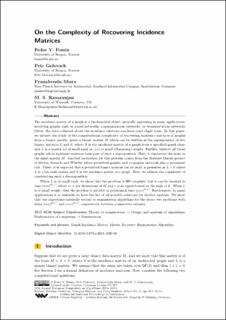On the Complexity of Recovering Incidence Matrices
Journal article, Peer reviewed
Published version

Åpne
Permanent lenke
https://hdl.handle.net/11250/2755699Utgivelsesdato
2020Metadata
Vis full innførselSamlinger
- Department of Informatics [928]
- Registrations from Cristin [9791]
Originalversjon
Leibniz International Proceedings in Informatics. 2020, 173, 50:1-50:13 10.4230/LIPIcs.ESA.2020.50Sammendrag
The incidence matrix of a graph is a fundamental object naturally appearing in many applications, involving graphs such as social networks, communication networks, or transportation networks. Often, the data collected about the incidence relations can have some slight noise. In this paper, we initiate the study of the computational complexity of recovering incidence matrices of graphs from a binary matrix: given a binary matrix M which can be written as the superposition of two binary matrices L and S, where S is the incidence matrix of a graph from a specified graph class, and L is a matrix (i) of small rank or, (ii) of small (Hamming) weight. Further, identify all those graphs whose incidence matrices form part of such a superposition. Here, L represents the noise in the input matrix M. Another motivation for this problem comes from the Matroid Minors project of Geelen, Gerards and Whittle, where perturbed graphic and co-graphic matroids play a prominent role. There, it is expected that a perturbed binary matroid (or its dual) is presented as L+S where L is a low rank matrix and S is the incidence matrix of a graph. Here, we address the complexity of constructing such a decomposition. When L is of small rank, we show that the problem is NP-complete, but it can be decided in time (mn)^O(r), where m,n are dimensions of M and r is an upper-bound on the rank of L. When L is of small weight, then the problem is solvable in polynomial time (mn)^O(1). Furthermore, in many applications it is desirable to have the list of all possible solutions for further analysis. We show that our algorithms naturally extend to enumeration algorithms for the above two problems with delay (mn)^O(r) and (mn)^O(1), respectively, between consecutive outputs.
